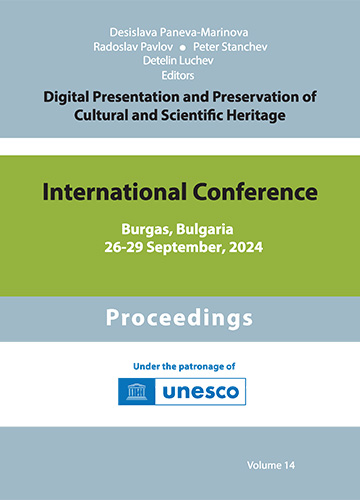Discover the Thracians – An Approach for Use of 2D and 3D Technologies for Digitization of Cultural Heritage in the Field of Elearning
DOI:
https://doi.org/10.55630/dipp.2012.2.9Keywords:
2D technologies, 3D technologies, multimedia content, e-learning, digitization, cultural heritage, ThraciansAbstract
Information and communication technologies (ICT) offer an easier access to and a multiperspective view of cultural heritage artifacts and may also enrich and improve cultural heritage education through the adoption of innovative learning/teaching methods. This paper examines the different practices and opportunities for digitization of cultural artifacts with historical significance and describes the work on a pilot project concerning the development of elearning materials in the Thracian cultural and historical heritage. The proposed method presents an approach based on a combination of 2D and 3D technologies to facilitate the overall process of digitization of individual objects. This approach not only provides greater opportunities for presenting the Thracian heritage but also new perspectives for studying it – students, scientists, PhD students will have the opportunity to work with the materials without having access to them.References
Ott, M., Pozzi, F.: Towards a new era for Cultural Heritage Education: Discussing the role of ICT. Computers in Human Behavior 27, – (2011)
Van der Leeuw-Roord, J.Heritage and history education at schools.In: Proceedings of The Europa nostra forum – Heritage and education: A European perspective, pp. 39 – 41, The Hague, (2005)
Larue, F., Di Benedetto, M., Dellepiane, M., Scopigno, R.: From the Digitization of Cultural Artifacts to the Web Publishing of Digital 3D Collections: an Automatic Pipeline for Knowledge Sharing. Journal of Multimedia 7 (2), 132 – 144 (2012)
Lee, K., Xu, X.W.: 3-D Digitization Methodologies for Cultural Artifacts. In: Encyclopedia of Information Science and Technology, Second Edition, DOI: 10.4018/978-1-60566- 026-4.ch598, pp. 3750 – 3757 (2009)
White, M., et al.: ARCO - An Architecture for Digitization, Management and Presentation of Virtual Exhibitions. In: Computer Graphics International (CGI'04), pp.622 – 625 ( )
Zhang, M.-M., Pan, Z.-G., Ren, L.-F., Wang, P.: Imagebased Virtual Exhibit and Its Extension to 3D. International Journal of Automation and Computing 4(1), 18 – ( )
Guidi, G., Micoli, L., Russo, M., Frischer, B., De Simone, M., Spinetti, A., Carosso, L.: 3D Digitization of a Large Model of Imperial Rome. In: Proceedings of Fifth International Conference on 3-D Digital Imaging and Modeling, Ottawa (Ontario, Canada), 13 – Giugno, pp. 565 – ( )
Díaz -Andreu, M., Brooke, C., Rainsbury, M., Rosser, N.: The Spiral that Vanished: The Application of Non-Contact Recording Techniques to an Elusive Rock Art Motif at Castlerigg Stone Circle in Cumbria. The Journal of Archaeological Science 33, 1580 – (2006)
Kumar, S., Snyder, D., Duncan, D., Cohen, J., Cooper, J.: Digital Preservation of Ancient Cuneiform Tablets Using 3D-Scanning. In: Proceedings of Fourth International Conference on 3D Digital Imaging and Modeling, pp. 326 – 333 (2003)
Pavlidis, G., Koutsoudis, A., Arnaoutoglou, F., Tsioukas, V., Chamzas, C.: Methods for 3D digitization of Cultural Heritage. Journal of Cultural Heritage 8, 93 – 98 (2007)
Surendran, S., et al.: Arthroscopic reconstruction of anterior cruciate ligament with preservation of the remnants. Orthopedic Journal of China 15(22), 1691 – (2007)
Baumberg, A., Lyons, A., Taylor, R.: 3D S.O.M. - A Commercial Software Solution to 3D Scanning. In: Vision, Video, and Graphics, The Eurographics Association, Eurographics Partner Event Vision, Video, and Graphics, Bath UK (2003)




